The transcriptional mediator subunit MED1/TRAP220 in stromal cells is involved in hematopoietic stem/progenitor cell support through osteopontin expression
- PMID: 20713445
- PMCID: PMC2950551
- DOI: 10.1128/MCB.01348-09
The transcriptional mediator subunit MED1/TRAP220 in stromal cells is involved in hematopoietic stem/progenitor cell support through osteopontin expression
Abstract
MED1/TRAP220, a subunit of the transcriptional Mediator/TRAP complex, is crucial for various biological events through its interaction with distinct activators, such as nuclear receptors and GATA family activators. In hematopoiesis, MED1 plays a pivotal role in optimal nuclear receptor-mediated myelomonopoiesis and GATA-1-induced erythropoiesis. In this study, we present evidence that MED1 in stromal cells is involved in supporting hematopoietic stem and/or progenitor cells (HSPCs) through osteopontin (OPN) expression. We found that the proliferation of bone marrow (BM) cells cocultured with MED1 knockout (Med1(-/-)) mouse embryonic fibroblasts (MEFs) was significantly suppressed compared to the control. Furthermore, the number of long-term culture-initiating cells (LTC-ICs) was attenuated for BM cells cocultured with Med1(-/-) MEFs. The vitamin D receptor (VDR)- and Runx2-mediated expression of OPN, as well as Mediator recruitment to the Opn promoter, was specifically attenuated in the Med1(-/-) MEFs. Addition of OPN to these MEFs restored the growth of cocultured BM cells and the number of LTC-ICs, both of which were attenuated by the addition of the anti-OPN antibody to Med1(+/+) MEFs and to BM stromal cells. Consequently, MED1 in niche appears to play an important role in supporting HSPCs by upregulating VDR- and Runx2-mediated transcription on the Opn promoter.
Figures

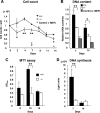

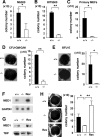
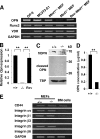
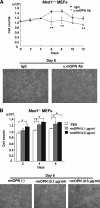




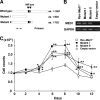
Similar articles
-
Periostin supports hematopoietic progenitor cells and niche-dependent myeloblastoma cells in vitro.Biochem Biophys Res Commun. 2016 Sep 30;478(4):1706-12. doi: 10.1016/j.bbrc.2016.09.008. Epub 2016 Sep 3. Biochem Biophys Res Commun. 2016. PMID: 27596966 Free PMC article.
-
FGF7 supports hematopoietic stem and progenitor cells and niche-dependent myeloblastoma cells via autocrine action on bone marrow stromal cells in vitro.Biochem Biophys Res Commun. 2013 Oct 11;440(1):125-31. doi: 10.1016/j.bbrc.2013.09.044. Epub 2013 Sep 16. Biochem Biophys Res Commun. 2013. PMID: 24051090
-
Specific erythroid-lineage defect in mice conditionally deficient for Mediator subunit Med1.Proc Natl Acad Sci U S A. 2010 Dec 14;107(50):21541-6. doi: 10.1073/pnas.1005794107. Epub 2010 Nov 23. Proc Natl Acad Sci U S A. 2010. PMID: 21098667 Free PMC article.
-
Alternative mechanisms by which mediator subunit MED1/TRAP220 regulates peroxisome proliferator-activated receptor gamma-stimulated adipogenesis and target gene expression.Mol Cell Biol. 2008 Feb;28(3):1081-91. doi: 10.1128/MCB.00967-07. Epub 2007 Nov 26. Mol Cell Biol. 2008. PMID: 18039840 Free PMC article.
-
Estrogen receptor coactivator Mediator Subunit 1 (MED1) as a tissue-specific therapeutic target in breast cancer.J Zhejiang Univ Sci B. 2019 May;20(5):381-390. doi: 10.1631/jzus.B1900163. J Zhejiang Univ Sci B. 2019. PMID: 31090264 Free PMC article. Review.
Cited by
-
Periostin supports hematopoietic progenitor cells and niche-dependent myeloblastoma cells in vitro.Biochem Biophys Res Commun. 2016 Sep 30;478(4):1706-12. doi: 10.1016/j.bbrc.2016.09.008. Epub 2016 Sep 3. Biochem Biophys Res Commun. 2016. PMID: 27596966 Free PMC article.
-
1,25(OH)2D3 regulates the proangiogenic activity of pericyte through VDR-mediated modulation of VEGF production and signaling of VEGF and PDGF receptors.FASEB Bioadv. 2019 Jul;1(7):415-434. doi: 10.1096/fba.2018-00067. Epub 2019 May 3. FASEB Bioadv. 2019. PMID: 31396585 Free PMC article.
-
Mediator subunit MED1 is a T3-dependent and T3-independent coactivator on the thyrotropin β gene promoter.Biochem Biophys Res Commun. 2013 Oct 11;440(1):184-9. doi: 10.1016/j.bbrc.2013.09.061. Epub 2013 Sep 18. Biochem Biophys Res Commun. 2013. PMID: 24055033 Free PMC article.
-
Bone marrow mesenchymal stem cells for improving hematopoietic function: an in vitro and in vivo model. Part 2: Effect on bone marrow microenvironment.PLoS One. 2011;6(10):e26241. doi: 10.1371/journal.pone.0026241. Epub 2011 Oct 20. PLoS One. 2011. PMID: 22028841 Free PMC article.
-
Mediator subunits MED1 and MED24 cooperatively contribute to pubertal mammary gland development and growth of breast carcinoma cells.Mol Cell Biol. 2012 Apr;32(8):1483-95. doi: 10.1128/MCB.05245-11. Epub 2012 Feb 13. Mol Cell Biol. 2012. PMID: 22331469 Free PMC article.
References
-
- Adams, G. B., and D. T. Scadden. 2006. The hematopoietic stem cell in its place. Nat. Immunol. 7:333-337. - PubMed
-
- Askmyr, M., N. A. Sims, T. J. Martin, and L. E. Purton. 2009. What is the true nature of the osteoblastic hematopoietic stem cell niche? Trends Endocrinol. Metab. 20:303-309. - PubMed
-
- Chang, P. L., M. Cao, and P. Hicks. 2003. Osteopontin induction is required for tumor promoter-induced transformation of preneoplastic mouse cells. Carcinogenesis 24:1749-1758. - PubMed
-
- Conaway, R. C., S. Sato, C. Tomomori-Sato, T. Yao, and J. W. Conaway. 2005. The mammalian mediator complex and its role in transcriptional regulation. Trends Biochem. Sci. 30:250-255. - PubMed
-
- Fan, X., D. M. Chou, and K. Struhl. 2006. Activator-specific recruitment of Mediator in vivo. Nat. Struct. Mol. Biol. 13:117-120. - PubMed
Publication types
MeSH terms
Substances
Grants and funding
LinkOut - more resources
Full Text Sources
Medical
Molecular Biology Databases
Research Materials
